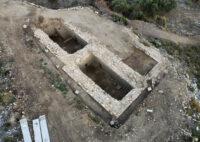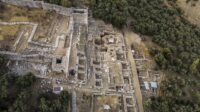 Four Roman-era cisterns have been unearthed at the ancient Ionian city of Metropolis (no really) 25 miles southeast of Izmir in western Turkey. They date to the late Roman, early Byzantine period around 1,500 years ago and had an estimated combined water capacity of 600 tons. The cisterns were found preserved in excellent condition under more than 20 feet of fill.
Four Roman-era cisterns have been unearthed at the ancient Ionian city of Metropolis (no really) 25 miles southeast of Izmir in western Turkey. They date to the late Roman, early Byzantine period around 1,500 years ago and had an estimated combined water capacity of 600 tons. The cisterns were found preserved in excellent condition under more than 20 feet of fill.
The cisterns were built adjacent to each other in the acropolis, the highest part of the terraced hilltop city, for use as reservoirs in case a siege cut off access to the lower city’s water supply. The cisterns had thick fortified walls to protect the precious resource and would have supplied drinking water to residents, irrigation to fields and water to the public baths.
Professor Serdar Aybek from Manisa Celal Bayar University’s Archeology Department touched upon the importance of the new findings.
“We are excited to open a new door to the daily lives of ancient people that lived in the region 1,500 years ago. The new discovery of four cisterns in the acropolis prove the skills of the ancient masters of Metropolis in the field of water engineering,” he told Demirören News Agency (DHA). […]
“(We) estimate that the cisterns supplied water to the entire settlement on the lower slopes of the acropolis, and particularly to the upper bathhouse structure. The cisterns, which are approximately three floors tall, are also of great importance in terms of being the best-preserved monuments in Metropolis,” Aybek said.
 The excavation of the cistern area has revealed large quantities of animal bones and pottery fragments. They are likely medieval and indicate the cisterns were used as giant dumpsters in the 12th and 13th centuries, which at least partially explains how these structures were so buried deeply.
The excavation of the cistern area has revealed large quantities of animal bones and pottery fragments. They are likely medieval and indicate the cisterns were used as giant dumpsters in the 12th and 13th centuries, which at least partially explains how these structures were so buried deeply.
The earliest evidence of human occupation at Metropolis dates to the Neolithic era. In the Bronze Age it was part of the kingdom of Arzawa that became a Hittite vassal state in the 14th century B.C., albeit a restless one. It joined forces with Mycenaean Greece against the Hittites several times, and Mycenaean cultural influence is evident in the remains of pottery discovered at the site. In the Hellenistic era it was part of the kingdom of Pergamum which was bequeathed by its last king Attalus III to the Roman Republic in 133 B.C. Under Rome, Metropolis expanded Most of the earliest surviving structures of the city date to the Hellenistic and Roman periods.